-
About Us
 Founded by the Congregation of CMI
Founded by the Congregation of CMIRCBS focuses not only on academic excellence, but also on the formation of students who are global citizens dedicated to a more just society
-
Campus
 Discover RCBS
Discover RCBSVisit RCBS to learn how supportive faculty, rigorous academics, diverse student organizations and a stunning 384-acre campus combine to make for an unparalleled college experience.
-
People
 More than a college, we are a family
More than a college, we are a familyWe recognize the investment each family makes in a RCBS, and we are proud of the value we offer in return.
-
Programs
 Education for the Heart & the Mind
Education for the Heart & the MindOur programs in the arts, sciences and business administration emphasize deep understanding and effective practice.
-
Research
 Education for the Heart & the Mind
Education for the Heart & the MindOur programs in the arts, sciences and business administration emphasize deep understanding and effective practice.
-
Student Life
 Immersive Learning Experience
Immersive Learning ExperienceRCBS focuses not only on academic excellence, but also on the formation of students who are global citizens dedicated to a more just society.
-
Career Support
 A dream career takes flight.
A dream career takes flight.RCBS focuses not only on academic excellence, but also on the formation of students who are global citizens dedicated to a more just society.
-
Admissions
 Relentlessly towards Excellence
Relentlessly towards ExcellenceRCBS focuses not only on academic excellence, but also on the formation of students who are global citizens dedicated to a more just society
- Examinations




